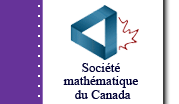Nous avons trouvé 32 articles correspondant à votre recherche.
 |
 |
 |
 |
 |
 |
|
|
| |

Cette unité montre l'intégration des mathématiques (la géométrie en particulier) et des arts visuels par l'entremise des oeuvres de M.C. Escher.
|
AUTEUR(S): Diane Hanson

|
 |
|
|
| |

Recensement à l‘école est un projet international en
ligne qui permet aux élèves de la 4e année au Cégep (12e année) de
découvrir le monde des enquêtes et de la statistique. Les élèves
remplissent de façon anonyme un questionnaire d‘enquête en classe.
Les enseignants ont accès aux résultats d’enquête de leur classe
sous forme de chiffrier qu’ils peuvent utiliser pour enseigner des
notions de statistique. Recensement à l’école offre aux élèves une
occasion unique de participer à la collecte et à l‘analyse de leurs
propres données.
|
AUTEUR(S): Statistique Canada

|
 |
|
|
| |

Vérifiez la théorie qu’illustre le fameux croquis de Léonard de Vinci—selon laquelle l’étendue des bras est égale à la taille—en utilisant un échantillon d’élèves de votre classe.
|
AUTEUR(S): Census at School - New Zealand

|
 |
|
|
| |

Amusez-vous à déterminer l’âge selon différentes unités de temps : minutes, jours, mois…
|
AUTEUR(S): CensusAtSchool – U.K.

|
 |
|
|
| |

Prédisez votre taille adulte d’après votre taille actuelle.
|
AUTEUR(S): CensusAtSchool – U.K

|
 |
|
|
| |

A brief history and description of the 4-colour theorem and its proof.
|
AUTEUR(S): Chris Fisher

|
 |
|
|
| |

Aboriginal Perspectives is a companion web site to Math Central. It is part of Mathematics with a Human Face. The purpose is to create and make available lesson ideas for teachers, constructed around video clips with an Aboriginal focus. The site is under construction and in its infancy but the intent is that the number of video clips will increase and the lessons will span all areas of the curriculum.
Proceed to Aboriginal Perspectives.
|
AUTEUR(S): Faculty and Students at the University of Regina

|
 |
|
|
| |

Karen designed this website to assist teachers and pre-service teachers in the area of mathematics from Kindergarten to Grade 12 . Here you will find a multitude of teacher resources to assist you in incorporating Aboriginal content in your mathematics program.
|
AUTEUR(S): Karen Arnason

|
 |
|
|
| |

This resource contains instructions on building a uniform polyhedra "star ball" from modules of folded paper. Animation is used to illustrate the folding of the paper. Students are then challenged to construct other uniform polyhedra from the same modules and to discover how they can be "coloured" by using coloured paper. The construction should be possible for beginning middle year students and some of the questions challenging to students at the upper secondary level.
|
AUTEUR(S): Stacey Wagner and Jason Stein

|
 |
|
|
| |

This note is a response to a question sent to Quandaries and Queries by Ben Dixon asking how to approximate pi. Chris wrote a nice description of the method used by Archimedes in approximately 250 BC.
|
AUTEUR(S): Chris Fisher

|
 |
|
|
| |

The atlatl and dart, the predecessor to the bow and arrow, was very important in the lives of Aboriginals in Saskatchewan and all over the world up until about 2000 years ago. Experiment based lessons allow students to learn about the science behind the weapon system that put humans on top of the food chain. Subject integrated lessons for grades 4-12 in the areas of math, science and social studies based on Saskatchewan curriculum objectives.
|
AUTEUR(S): Janice Cotcher

|
 |
|
|
| |

A personal project developed to create enrichment activities for Geoboards, Napier Rods, and Bean Sticks. Includes annotated links to problem solving Internet Sites.
|
AUTEUR(S): Brett Paddock

|
 |
|
|
| |

Calculating the area of a rectangles, circles, triangles etc.has been been a regular exercise for students of mathematics. Unfortunately much of the world is irregular in shape and design. This exercise introduces the students to estimating the area of irregular surfaces.
|
AUTEUR(S): Bruce Hermsmeier

|
 |
|
|
| |

In this article Judi and Harley illustrate the seven frieze patterns using art of the indigenous peoples of North America. They then develope some of the mathematics of frieze patterns at a level that is accessible to many students. The teacher notes contain activities with frieze patterns for students at all levels.
|
AUTEUR(S): Judi McDonald and Harley Weston

|
 |
|
|
| |

This article is part of the Mathematics Notes series at Washington State University. In the article, Judi and Harley start by determining the functions that map the plane back onto itself, while at the same time, mapping a specified line back onto itself and preserving the size and shape of any objects represented in the plane. These are the functions that preserve frieze patterns. The authors then look at the algebraic structure of this collection of functions under the operation of composition, show that there are only seven frieze groups, and illustrate how they are generated. Each frieze group is represented algebraically and geometrically. The article concludes with a tour of the Washington State University campus, looking at the ways in which frieze groups are exhibited and used in our immediate surroundings.
|
AUTEUR(S): Judith J. McDonald and J. Harley Weston

|

